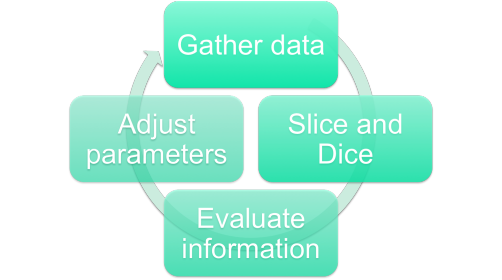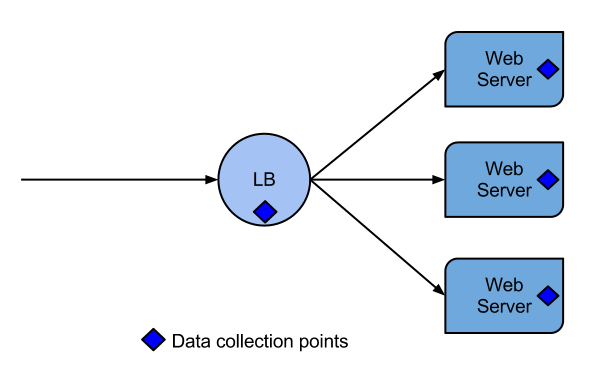The feedback cycle and runtime governance
Introduction
Runtime governance can be defined as the process which allows you to control and manage parameters in your runtime execution environment. A runtime execution environment can vary from a single web server that hosts a simple web page, to gigantic deployments that can span to 1000+ servers. This means the complexity of implementing runtime governance can depend heavily on how complex the runtime environment actually is. A feedback cycle allows to continuously get feedback from the runtime system to govern it more effectively. This article briefly explains how a feedback cycle is important to the runtime governance process.
The feedback cycle
The feedback cycle defines a model that is common to any runtime execution environment. The four stages can be related to any environment regardless of its size.

Each stage is elaborated on below:
1. Gather data
The gathering of data is the starting point of the feedback cycle. Data can be distributed among many points in a runtime environment. Let’s consider a deployment consisting of a web server. If it is a clustered deployments, all web servers can be potential data collection points. The other option is, if there is a load balancer in front of the cluster, to use the LB as the data collection point. But, this might impact the performance of the load balancer. So, the performance cost needs to be compensated for in terms of additional LBs, depending on the requests per second is affected.

The second option to ponder is what type of data to collect. Typically, the more data you collect the better. This might vary from CPU cycles consumed by the servers to the HTTP headers of all requests. All types of data can be used to generate some sort of useful information.
2. Slice and Dice
After gathering data, the second part of the cycle is to generate useful information through slicing and dicing the data. Real time analysis maybe needed to prevent imminent security threats. For example, a 30 second window maybe enough to send enough requests from multiple IPs to overwhelm a medium sized website. Batch-based analytics maybe needed for trend analysis over timespans. A combination of batch based and batch based analytics seems to be the most viable option for a variety of requirements of generating useful information quickly and over a large time period. There are various tools in the landscapes of complex event processing and data analytics that allow to rapidly perform analytics to produce useful information.
3. Evaluate Information
The third step of the cycle deals with the fact that each piece of information can present some vital insight about your runtime execution. You notice that website visits are doubling each month. At this point it should be evaluated whether this is just a temporary trend or is this the effect of any recent improvements. Also, you may notice a trend of some increasing downtime among your servers. Maybe, this is related to some sort of attack taking place or some unreliable hardware. Usually, domain knowledge and solution architecture expertise needs to be heavily utilized to make these insights as these may lead to heavy resource investments.
4. Adjust parameters
The final step of the cycle bridges the feedback cycle to runtime governance. Tuning your parameters to effectively govern your environment is done in this step. This may mean you need more server capacity or some additional steps to boost security and strengthen the site’s resilience based on this observation. Policies can be altered, introduced or decommissioned based on the information given by the feedback cycle.
Conclusion
Based on information gathered from the feedback cycle, the effectiveness of the runtime environment can be judged and altered. It even allows you to get an idea about missing components that are needed for more effective runtime governance. Feedback cycles can also be stretched beyond typical runtime governance applications to understand various trends about server uptime, API analytics and business activity monitoring to get more insight about a business and associated trends.
Reference: The feedback cycle and runtime governance from our JCG partner Mackie Mathew at the dev_religion blog.




